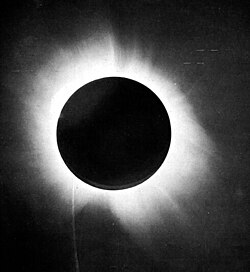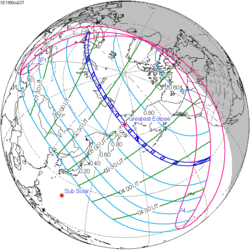| Total eclipse | |
| Gamma | 0.4658 |
|---|---|
| Magnitude | 1.0292 |
| Maximum eclipse | |
| Duration | 143 s (2 min 23 s) |
| Coordinates | 50°54′N152°00′W / 50.9°N 152°W |
| Max. width of band | 112 km (70 mi) |
| Times (UTC) | |
| Greatest eclipse | 22:07:43 |
| References | |
| Saros | 126 (42 of 72) |
| Catalog # (SE5000) | 9324 |
A total solar eclipse occurred at the Moon's descending node of orbit between Saturday, June 8 and Sunday, June 9, 1918, [1] with a magnitude of 1.0292. A solar eclipse occurs when the Moon passes between Earth and the Sun, thereby totally or partly obscuring the image of the Sun for a viewer on Earth. A total solar eclipse occurs when the Moon's apparent diameter is larger than the Sun's, blocking all direct sunlight, turning day into darkness. Totality occurs in a narrow path across Earth's surface, with the partial solar eclipse visible over a surrounding region thousands of kilometres wide. Occurring 3.7 days after perigee (on June 5, 1918, at 8:40 UTC), the Moon's apparent diameter was larger. [2]
Contents
- The Path
- U.S. Observation team
- Observation
- Eclipse details
- Eclipse season
- Related eclipses
- Eclipses in 1918
- Metonic
- Tzolkinex
- Half-Saros
- Tritos
- Solar Saros 126
- Inex
- Triad
- Solar eclipses of 1916–1920
- Saros 126
- Metonic series
- Tritos series
- Inex series
- Notes
- Other links
The eclipse was viewable across the entire contiguous United States, an event which would not occur again until the solar eclipse of August 21, 2017.











































































































